
Posts Tagged: salinity
Optimizing Salt Leaching
With little rain this winter and the erratic weather patterns of wind and heat, avocado is going to be especially prone to salt damage. And the flowering period is one of the most sensitive. Flowers are competing with leaves that have been hanging on for a year and have been salt stressed by a year's worth of irrigation salts. A good understanding of how salt moves and is leached it important to get through til next winter when there will hopefully be sufficient rain again to naturally leach the soil.
Water moves in a wetting front. When irrigation water hits the soil, it moves down with the pull of gravity and to the side according to the pull of soil particles (more lateral with more clay). Soil is a jumble of different sized soil particles, from clay to silt to sand sizes and then often intermixed with stones of different sizes from gravels to boulder. The different textures determine how water moves. It moves fastest through coarse textures and slowest through finer ones – the clays, the ones with the smallest pores. But soils are a jumble of particle sizes and pores.
Water first moves down the larger pores and then it slowly moves through the smaller ones. As water moves through the soil, it carries salts that have accumulated in the soil. At the wetting front is where the salt accumulates. As the water moves through the larger pores, salts migrate/diffuse from the small pores to the larger ones. This diffusion takes a bit of time, so typically the small pores have a larger salt concentration than the larger ones.
So an initial application of water will carry the salts from these large pores and if the irrigator were to stop in mid-application, it allows time for the salts to move out of the small pores into the larger ones. Then when the irrigation recommences, it will carry more of the salts out of the wetted area – the root zone. This technique is called “bumping” where an irrigation is stopped and then restarted in order to improve not only leaching, but also reduce runoff.
This principle also is at play when there are two or more sources of water quality. Soil salinity can be no lower than the irrigation water that is applied. Then as the soil, water is removed through plant absorption or evaporation, the salinity increases. The soil salinity can easily be two to three times higher than the irrigation water.
If there are two sources of water, the initial application can be with the poorer quality water, and once that has reduced the soil salinity, then the better water quality can be applied which will then bring the soil salinity closer to that of the better quality water. By doing this two part leaching, the amount applied of the better quality water can be significantly reduced. This is a type of “bumping” to improve leaching.
Watch this U-Tube video on how water moves through soil, thanks to the work at Walla Walla Community College.
https://www.youtube.com/watch?feature=player_detailpage&v=J729VzBeI_g
Thank you Walla Walla Community College for the video

soil salinity irrigation
What Impact Salinity on Avocado?
Water Quality Impacts on California Avocado –
A Collaborative Approach
Sat Darshan S. Khalsa1 and Ben Faber2
1Department of Plant Sciences, UC Davis
2Cooperative Extension Ventura County, UCANR
Avocado consumption continues to grow both in the U.S. and around the globe. Greater demand creates an opportunity for growers to supply an expanding market with quality California fruit. More intensive production increases the need for attention to tree health, crop protection and irrigation practices. Many avocado root rot diseases are related to how growers manage water, and given the salt sensitivity of avocado and limited selection of salt-resistant rootstocks, water quality is an inherent driver of avocado productivity and quality.
In the California avocado-growing regions of the Central and South coast, water quality can be highly variable. Groves can rely on a combination of surface and groundwater yet, water high in total dissolved solids, pH and salts such as sodium and chloride, can be common place. Furthermore, water quality properties are subject to change as California faces more weather extremes and shifting water demand. As a result, avocado growers need to continue to be conscientious of how local and regional water quality conditions impact their groves.
A comprehensive understanding of how water quality impacts avocado tree health and fruit quality is still limited. The consensus is irrigation with poor quality water reduces crop productivity yet, the extent to which crop loss is linked to water quality and specific practices to mitigate the risk is not entirely clear. The clonal rootstocks ‘Dusa', ‘Toro Canyon' and ‘Duke 7' have some salt tolerance, but are still sensitive to salts. Even less information is available on the potential impacts of water quality on fruit quality, including both nutritional value and postharvest storage.
A collaborative approach to problem-solving creates an opportunity for growers to participate in research and to generate regional and site specific solutions. The phases of this project include 1) identify the range of water quality conditions in California avocado-growing regions; 2) build a network of ‘focus sites' identified by grower participants using specific grove characteristics and; 3) monitor field indicators to quantify impacts of water quality on tree health and fruit quality. Results will be shared in aggregate to maintain the privacy of participants and also, allow growers to compare their focus site with a wider population.
If you are interested in learning more about this collaborative water quality project, please contact Dr. Khalsa at sdskhalsa@ucdavis.edu or sign up for a follow-up conversation using this webform (http://madmimi.com/signups/fbeac7dee8264fac90ab8a9b6f0c65ff/join).
Sat Darshan Khalsa is an Assistant Project Scientist in the Department of Plant Sciences at UC Davis (http://www.plantsciences.ucdavis.edu/people/sat-darshan-khalsa) and Ben Faber is the UCANR Soils/Water/Subtropical Crops Advisor for Ventura and Santa Barbara Counties (http://ceventura.ucanr.edu/Staff/?facultyid=638).
Photo: These aren't avocados.

salt rings
A More Water Efficient Avocado?
Here's a pretty technical report of water efficiency in avocado - the amount of water it takes to make fruit. It looks like there might be some varieties that could produce more fruit with less water. It's a promising start to selecting a tree that could produce under the increasing drought conditions found in avocado growing areas.
Evaluation of leaf carbon isotopes and functional traits in avocado reveals water-use efficient cultivars
Plant water-use efficiency (WUE) describes the ratio of carbon gain to water loss during photosynthesis. It has been shown that WUE varies among crop genotypes, and crops with high WUE can increase agricultural production in the face of finite water supply. We used measures of leaf carbon isotopic composition to compare WUE among 24 cultivars of Persea americana Mill (avocado) to determine genotypic variability in WUE, identify potentially efficient cultivars, and to better understand how breeding for yield and fruit quality has affected WUE. To validate carbon isotope measurements, we also measured leaf photosynthetic gas exchange of water and carbon, and leaf and stem functional traits of cultivars with the highest and lowest carbon isotope composition to quantify actual WUE ranges during photosynthesis. Our results indicate large variation in WUE among cultivars and coordination among functional traits that structure trade-offs in water loss and carbon gain. Identifying cultivars of subtropical tree crops that are efficient in terms of water use is critical for maintaining a high level of food production under limited water supply. Plant functional traits, including carbon isotopes, appear to be an effective tool for identifying species or genotypes with particular carbon and water economies in managed ecosystems.
Read the article:
https://www.sciencedirect.com/science/article/pii/S0167880918301828

avocado fruit
What Caused that Symptom???
Diseases, disorders and other plant problems are critical concerns for the wholesale nursery. These include biotic problems — caused by living organisms such as pathogens, nematodes, and insects and other arthropods — as well as abiotic problems — caused by factors such as temperature and moisture extremes, mechanical damage, chemicals,
nutrient deficiencies or excesses, salt damage and other environmental factors. Many plant problems, especially biotic problems, if not recognized and controlled early in their development, can result in significant economic damage for the producer. Therefore, timely and accurate diagnoses are required so that appropriate pest and disease
management options and other corrective measures can be implemented.
Definition of Plant Diagnosis and Steps
Diagnosis is the science and art of identifying the agent or cause of the problem under investigation. When one renders a diagnosis, one has collected all available information, clues and observations and then arrives at an informed conclusion as to the causal factor(s). Hence, plant problem diagnosis is an investigative, problem-solving process that involves the following steps:
- Ask and answer the appropriate questions to define the problem and
obtain information that is relevant to the case under investigation.
- Conduct a detailed, thorough examination of the plants and production areas.
- Use appropriate field diagnostic kits and lab tests to obtain clinical information on possible causal agents and factors.
- Compile all the collected information and consult additional resources and references.
- Finally, make an informed diagnosis.
Throughout this process compile all notes, observations, maps, laboratory results, photographs and other information. This compilation will be the information base for the present diagnosis and can also be a useful resource for future diagnostic cases. Keep an open mind as the information is analyzed and do not make unwarranted assumptions.
Distinguishing Abiotic and Biotic Problems
The first step is to determine whether the problem is caused by an infectious agent, and this can be difficult. Plant symptoms caused by biotic factors such as infectious diseases and arthropod pests are oftensimilar to damage caused by other factors. Leaf spots, chlorosis, blights, deformities, defoliation, wilting, stunting and plant death can
be common symptoms of both biotic and abiotic problems; therefore, the presence of these symptoms does not necessarily mean the problem is a disease. Some general guidelines for distinguishing abiotic and biotic
problems follow and are summarized in table 1.
Table 1 DISTINGUISHING ABIOTIC AND BIOTIC PROBLEMS |
||
Characteristics |
Abiotic |
Biotic |
Hosts |
often affects several species or plants of various ages |
often affects one species or cultivar of the same age |
Pattern of plant symptoms |
often related to environmental or physical factors or cultural practices; may be regular or uniform |
often initially observed in random or irregular locations |
Rate of symptom development |
relatively uniform, extent of damage appears similar among plants |
relatively uneven, time of appearance and damage severity varies among affected plants |
Signs |
no evidence of the kinds of pests or pathogens known to cause the current symptoms |
presence of insects, mites, |
Spread |
is not infectious, is not progressive, commonly caused by one incident and does not spread |
infectious, spreads on host over time if environmental conditions are suitable |
Recurrence |
possibly previously associated with current or prior environmental conditions or cultural practices |
possibly caused by pests that |
Adapted from Table 18, ANR Pub 3420 |
||
Biotic problems. Identifying biotic problems is sometimes facilitated if signs of a pathogen, primarily the growth of a fungus, are present. The most obvious examples of such signs are the mycelium and spores produced by rusts and powdery and downy mildews. However, in other cases nonpathogenic fungican grow on top of damaged plant tissues and appear to be signs of a pathogen, resulting in possible misdiagnoses.
Biotic problems often affect one species or cultivar of the same age and typically are initially observed in random or irregular locations; symptoms appear at varying times, and severity varies among affected plants. Biotic problems are infectious, spreading when environmental conditions are favorable, and may be associated with pests that have affected the crop. This infectious aspect is important, as biotic diseases will many times be progressive and continue to affect
additional tissues and more plants.
Abiotic problems. In contrast to biotic factors, abiotic problems often affect several species or plants of various ages; typically, damage is relatively uniform, doesn't spread and is often not progressive. Abiotic problems are not associated with pests. They are often caused by a single incident and are related to environmental or physical factors or cultural practices. Once the responsible factor has dissipated and is no longer affecting the plant, the plant may grow out of the problem and develop new, normal appearing foliage.
Diagnosing Biotic Problems
Infectious diseases. To confirm if a problem is caused by a pathogenic fungus, bacterium, nematode, or virus, it is often necessary to have symptomatic tissues analyzed by a trained horticulturalist or plant pathologist. Such experts will attempt to microscopically observe the agent and recover it, if culturable, through isolation procedures. Lab analysis is particularly important to determine if multiple pathogens are infecting the plant. A downside is that obtaining a diagnosis from lab analysis is not a fast process. However, quick test kits (fig. 1A) are available that can be used to rapidly identify many common diseases in the field.
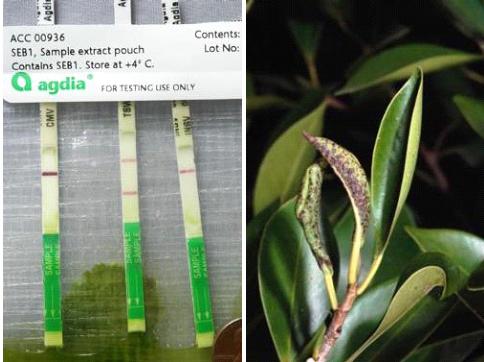
A B
Fig.1. Diagnosing biotic
problems. Plant pathogens can sometimes be rapidly diagnosed using
commercially available quick tests, such as these test strips for
viruses (A). Arthropod pests such as Cuban laurel thrips (shown here on Ficus) cause feeding damage, which can help in pest identification (B). Photos: S.T. Koike (A), J. K. Clark (B).
It is worthwhile to emphasize that diagnosing plant diseases requirescareful examination of the entire plant specimen. Symptoms on leaves, stems, or other above ground plant parts might lead one to suspect that afoliar pathogen is involved. However, these symptoms could also resultif the roots are diseased. Therefore, it is important to conduct a
complete examination of the symptomatic plant.
Because biotic diseases are caused by living microorganisms, the collecting and handling of samples is particularly critical. Samples that are stored for too long a time after collecting or that are allowedto dry out or become hot (if left inside a vehicle, for example) will sometimes cause the pathogen in the sample to die, making pathogen recovery and identification impossible. Plants that have been diseased for a long time and that are in the late stages of disease development will often be colonized by nonpathogenic saprophytic organisms. If these tissues are collected, it will be difficult to recover the primarypathogen of concern because of the presence of these secondary decay organisms. Root samples should be collected carefully as diseased rootsare sometimes difficult to dig out of the potting mix or soil, are
usually colonized by the pathogen as well as secondary agents, and are very sensitive to high temperatures and drying conditions.
Arthropod and other invertebrate pests. Insects,mites, slugs and snails cause damage while feeding on the plant (fig. 1B). Feeding damage is usually associated by the type of feeding characteristics and mouthparts of the insect or pest. For example, mites and insects such as whiteflies, aphids and mealybugs have tubular sucking mouthparts that suck plant fluids, causing buds, leaves, or flowers to discolor, distort, wilt, or drop. Thrips have rasping mouthparts that result in dried out, bleached plant tissue. Caterpillars, weevils, snails and slugs have chewing mouthparts that
make holes and cuts in foliage or flowers. They can also prune plant parts and sometimes consume entire plants.
If present, these pests are visible with the naked eye, a 10 X hand lens, or stereomicroscope, all depending upon their size. An assessment of whether the identified arthropod or invertebrate matches the plant damage it is associated with must be determined. Sometimes the identified arthropod or invertebrate may not be the sole problem or
could, in fact, be a beneficial organism or insignificant pest.
Aphids, whiteflies, thrips, leafhoppers and some other insects that suck plant juices may vector pathogens such as viruses and phytoplasmas (and to a lesser extent fungi and bacteria). They can feed on infected plants, acquire the pathogen, feed on healthy host plants and transmit the pathogen to the new host. The insects do not necessarily have to bepresent in large numbers to cause a significant disease outbreak. The insect vectors are not always present at the same time the disease symptoms are being expressed.
The excrement and byproducts from these pests can also provide clues that the pests have been or are actively present. Caterpillars and other chewing pests produce dark excrement or droppings. Greenhouse thrips and plant bugs produce dark, watery, or varnish-like droppings onfoliage. Aphids, whiteflies, soft scales, and some other sap-sucking insects excrete excess plant fluids as honeydew, a sticky sap, which provides a medium for the growth of sooty mold.
Diagnosing Abiotic Problems
Nutrient deficiencies and toxicities. Nutrientdeficiencies and toxicities reduce shoot growth and leaf size, cause leaf chlorosis (fig.2A), necrosis and dieback of plant parts. However, nutrient deficiencies cannot be reliably diagnosed on the basis of symptoms alone because numerous other plant problems can produce similarsymptoms. There are general symptoms that can be expressed by deficiencies of nutrients but usually leaf and/or soil samples are
needed to confirm the problem.
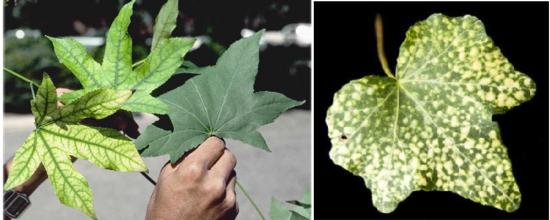
A B
Fig. 2. Examples of abiotic problems. Iron deficiency on sweet gum (Liquidambar styracifolia) showing interveinal chlorosis (A). Chorotic spots on Hedera caused by a miticide application at a higher dosage rate than specified on the pesticide label (B). Photos: E. Martin (A), S. A. Tjosvold (B).
Herbicide, insecticide and fungicide phytotoxicity. Herbicidesused to control weeds in crops or in non-cropped areas sometimes injureornamental crops when they are not used in accordance with label instructions. Examples include when an herbicide is used in or around sensitive non-target crops, when an herbicide rate is increased above tolerable limits, or when an applicator makes a careless application. By understanding the mode of action of the herbicide, one can determine if the symptom fits an herbicide application. Herbicide detection in affected plants is possible with the help of a specialized laboratory but the analysis can be expensive. To minimize the cost of testing, the laboratory will need to know the suspected herbicide or its chemical group to narrow the analysis. Pesticides and fungicides occasionally cause obvious plant damage.
Symptoms can vary widely. Generally, flower petals are more susceptible to damage from pesticide applications than are leaves. The younger and more tender the leaves the more susceptible they are to pesticide applications. Hot weather can exacerbate the damage the chemicals cause. Pesticides that have systemic action can have a more profound effect. Some active ingredients can adversely affect the photosynthetic mechanism or other physiological processes and can resulti n a general leaf chlorosis, interveinal chlorosis, leaf curling and stunting. Emulsifiable concentrate (EC) formulations, soaps and oils can adversely affect the waxy surface layer that protects the leaf from desiccation. Applications with these products can result in the loss ofthe shiny appearance of a leaf, leaf spotting and necrosis. Pesticidesapplied as soil drenches can cause poor germination, seedling death, or
distorted plant growth.
Check label precautions against use on certain species. Make sure thepesticide is not applied more frequently or at a higher rate (fig. 2B) than recommended, or that the pesticide is not mixed with incompatible pesticides. When in doubt as to whether the plant species is sensitive to the pesticide, spray a few plants and observe them for several days to a week for any signs of damage before spraying any more of the plants.
Physiological and Genetic Disorders
There are numerous disorders that can occur because of environmental extremes — too much or too little of an environmental element such as light, temperature, water, or wind. Sunburn is damage to foliage and other herbaceous plant parts caused by a combination of too much light and heat and insufficient moisture. A yellow or brown area develops on foliage, which then dies beginning in areas between the veins. Sunscaldis damage to bark caused by excessive light or heat. Damaged bark becomes cracked and sunken. Frost damage causes shoots, buds and
flowers to curl, turn brown or black and die. Hailstones injure leaves,twigs, and in serious cases even the bark. Chilling damage in sensitive plants can cause wilting of foliage and flowers and development of dark water-soaked spots on leaves that can eventually turn light brown or bleached, and die. Physical and mechanical injury can occur when plants are mishandled during transport or routine cultural practices. Wounds might serve as entry sites for plant pathogens and can attract boring insects to woody stems.
In closed environments such as greenhouses and nursery storage areas,plants can be exposed to toxic levels of ethylene gas. Sources of ethylene include improperly functioning or unvented greenhouse heaters; exhaust from engines of forklifts and vehicles; cigarette smoke; damaged, decaying, or dying plants; and ripe or decaying fruit. Toxic levels of ethylene gas can cause premature abscission of flower buds, petals (fig. 3) and leaves. Other symptoms include wilted flowers, chlorosis, twisted growth or downward bending of stems and leaves and undersized or narrow leaves.
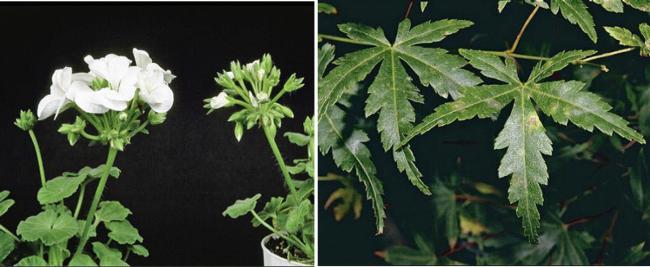
A B
Fig. 3. Poor air quality can
lead to physiological disorders. Shattering (petal drop) on geranium was
caused by plant exposure to low levels of ethylene in the greenhouse or
during postharvest storage (A). Yellowish and brownish patches on
Japanese maple leaves are damage caused by ozone (B), an outdoor air
pollutant. Photos: J. K. Clark.
Outdoors, exposure of nursery plants to air pollutant gases such as ozone (fig. 3), carbon monoxide, nitrous oxides and sulfur dioxide can cause damage. Typical symptoms vary widely, but include slow growth anddiscolored, dying, or prematurely dropping foliage. Damage is often found where plants are located near sources of polluted air such as near
freeways or industries or where weather and topography concentrate the pollutants.
Sometimes plants or plant shoots exhibit an unusual and sudden changeof color producing discrete markings of variegation. For example, a plant with entirely green leaves suddenly produces a shoot that has leaves with edges lacking green pigment, stripes, or blotches. A new shoot such as this is probably a chimera (fig. 4). It is produced when a genetic mutation occurs in a specific region of the growing tip resulting in a section with genetically different cells. The ostensible result of the genetic change is dependent on the arrangement of the genetically different cells in the shoot tip and their expression. This can lead to sometimes bizarre variegation forms or sometimes forms thatare quite desirable. Sometimes variegation can be caused by viruses. Viruses usually cause non-uniform chlorosis, such as mosaics, while
chimeras usually produce patterned forms such as variegation of color onleaf margins, stripes, or complete loss of pigment. Some viroids may also cause bleaching of pigments in leaves; such symptoms, however, are generally produced throughout the plant and are not restricted to a single shoot. Some nutrient disorders can cause variegation but these disorders usually do not arise from a specific shoot as with chimeras.
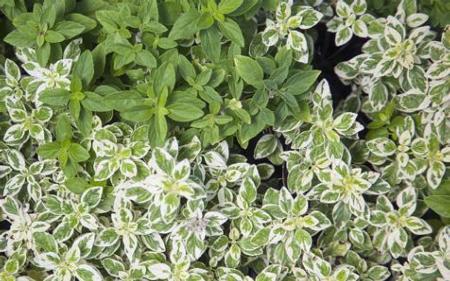
Fig. 4. Genetic disorder.
Growing points with variegated leaves can sometimes arise spontaneously
from some species such as this Origanum. Genetic variants such as this are sometimes confused with plants with virus disease or nutrient deficiency symptoms. Photo: S. A. Tjosvold.
Steve Tjosvold is Environmental Horticulture Advisor and
Steve Koike is Plant Pathology Farm Advisor, UC Cooperative Extension,
Santa Cruz and Monterey counties.
This article was condensed from: Diagnosing Plant
Problems, Chapter 11. In Newman, J. (ed) Container Nursery Production
and Business Management. Univ. of Calif. Agric. and Nat. Resources.
Publication 3540. Richmond, CA.
References
Boxer P, Sandmann G. 1989. Target sites of herbicide action. Boca Raton, FL: CRC Press.
Costello L, Perry E, Matheny N, Henry M, Geisel P. 2003. Abiotic
disorders of landscape plants: A diagnostic guide. Oakland: University
of California Division of Agriculture and Natural Resources Publication
3420.
Derr JF, Appleton BL. 1988. Herbicide injury to trees and shrubs: A
pictorial guide to symptom diagnosis. Virginia Beach, VA: Blue Crab
Press.
Dreistadt SH. 2001. Integrated pest management for floriculture and
nurseries. Oakland: University of California Division of Agriculture and
Natural Resources Publication 3402.
Eagle, DJ. 1981. Diagnosis of herbicide damage to crops. New York, NY: Chemical Publishing Co.
Grogan RG. 1981. The science and art of plant disease diagnosis. Annual Review of Phytopathology 19:333–351.
Ratzinger EJ, Mallory-Smith C. 1997. Classification of herbicides by
the site of action for weed resistance management strategies. Weed
Technology 11:384–393.
Schubert TS, Breman LL. 1988. Basic concepts of plant disease and how
to collect a sample for disease diagnosis. Plant Pathology Circular No.
307. Florida Department of Agriculture and Consumer Services, Plant
Pathology Circular No. 307.
Sharma MP. 1986. Recognizing herbicide action and injury. Alberta Environmental Centre, Alberta Agriculture. Agdex 641–647.
Shurtleff MC, Averre CW. 1997. The plant disease clinic and field
diagnosis of abiotic diseases. St. Paul, MN: American Phytopathological
Society Press.
Stewart TM, Galea VJ. 2006. Approaches to training practitioners in
the art and science of plant disease diagnosis. Plant Disease
90:539–547.
Tickes B, Cudney D, and Elmore C. 1996. Herbicide injury symptoms.
Tucson, AZ: University of Arizona Cooperative Extension Publication No.
195021.
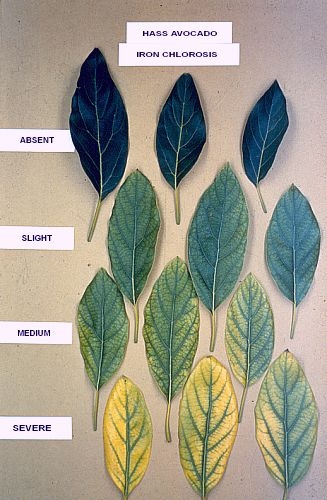
avocado chlorosis
Earthworms, Soil Productivity, Citrus and Avocado
There are 4,000 species of earthworms grouped into five families and distributed all over the world. Some grow uo to 3 feet long, while others are only a few tenths of inches. We call them nightcrawlers, field worms, manure worms, red worms and some people call them little diggers.
In California, we have some native species of earthworms, but in many cases non-native introduced species have come to dominate. The predominant native species belong to the Argilophilus and Diplocardia while many of the non-native are of European in origin in the Lumbricidae family. Many of these non-natives were probably introduced by settlers bringing plants from home, which had soil containing the worms. A survey of California earthworms by the US Forest Service can be found at:
https://www.fs.fed.us/psw/publications/documents/psw_gtr142/psw_gtr142.pdf
This is a wonderful description of earthworm biology and their occurrence in the landscape.
When digging in citrus orchards, it is common to find earthworms in the wetted mulch under tree canopies. Many of our citrus orchards were initially established by “balled and burlap” nursery trees that brought worms along with the soil. In the case of many avocado orchards, on the other hand, it can be rare to find earthworms in orchards. Most avocado orchards have been established since the 1970s when potting mixes and plastic liners were the standard practice and worms were not part of the planting media. Even though there is a thick leaf mulch in avocado orchards, the worms have not been introduced, and it is rare to find them.
Numerous investigators have pointed out the beneficial effects of earthworms on soil properties. One of the first of these observers was Charles Darwin who published Earthworms and Vegetable Mould in 1881. He remarked on the great quantity of soil the worms can move in a year. He estimated that the earthworms in some of his pastures could form a new layer of soil 7 inches thick in thirty years, or that they brought up about 20 tons of soil per acre, enough to form a layer 0.2-inch-deep each year.
Earthworms, where they flourish, are important agents in mixing the dead surface litter with the main body of the soil. They drag the leaves and other litter down into their burrows where soil microorganisms also begin digesting the material. Some earthworms can burrow as deeply as 5 to 6 feet, but most concentrate in the top 6 to 8 inches of soil.
The worm subsists on organic matter such as leaves and dead roots near the soil surface. The earthworm ingests soil particles along with the organic matter and grinds up the organic matter in a gizzard just as a chicken does. This is excreted in what we call worm casts. The castings differ chemically from the rest of the soil, as they are richer in nitrogen, potassium and other mineral constituents.
Castings are a natural by-product of worms. When added to normal soils in gardens or lawns, they provide the same kinds of benefits as other bulky organic fertilizers. Castings today are not commonly used as fertilizer by commercial plant growers because of their cost relative to other fertilizers. However, castings are used by some organic growers and are sold commercially as a soil amendment or planting medium for ornamental plants grown in pots.
The physical soil churning process also has several important effects:
-Organic residues are more rapidly degraded with the release of elements such as nitrogen, sulfur and other nutrients.
-Some of the inorganic soil minerals tend to be solubilized by the digestive process.
-Extensive burrowing improves soil aeration.
-Burrowing can improve water penetration into soils
-The earthworm carries surface nutrients from the soil surface and imports them into the root zone of the plant.
Although earthworms are considered beneficial to soil productivity, few valid studies have been made to determine whether their presence will significantly improve plant growth. This may seem odd since many of us have learned from childhood that worms are good. It is something like the chicken and the egg analogy. The conditions that are conducive to earthworms are also ideal for plants. Both plants and worms need temperatures between 60 and 100 degrees F for good growth; both need water, but not too much or little; they both require oxygen for respiration; and they do not like soils that are too acid or basic or too salty. By correcting soil conditions that are unfavorable for one will also improve the outlook for the other. The earthworm is a natural component of the soil population. If the soil is properly managed this natural population will thrive. In this sense, the presence or absence or earthworms can be an indicator of the "fertility" of one's soil.
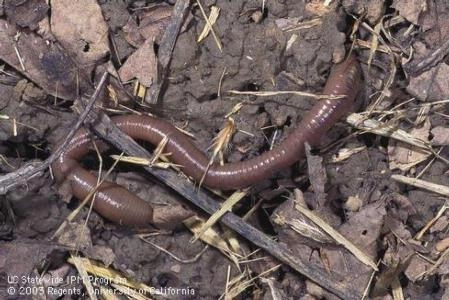
earthworm
